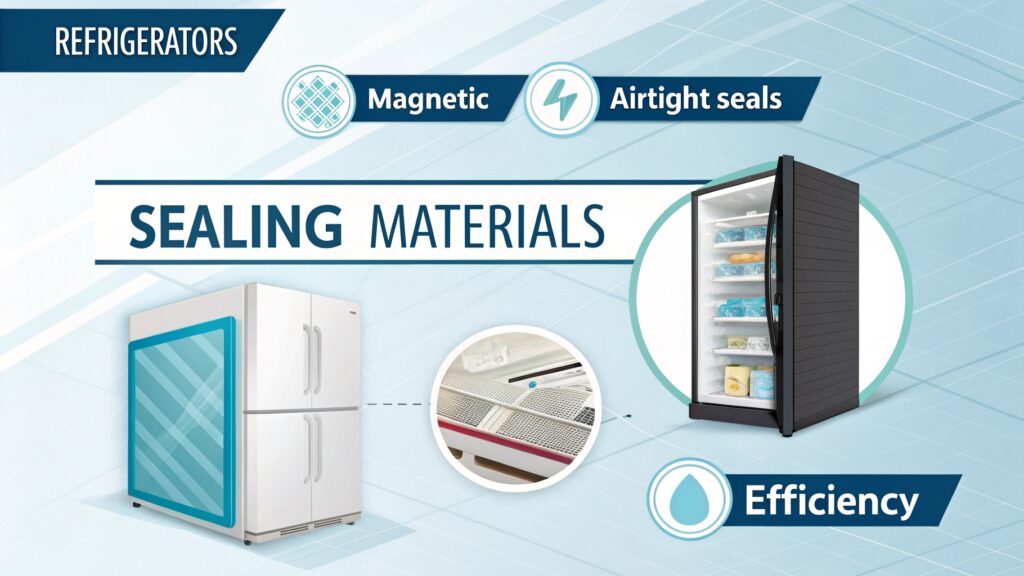Ever wondered what keeps your food cold? Behind the sleek exterior lies a carefully engineered mix of metals, plastics, and high-tech foam.
Refrigerators require steel/plastic for structure, polyurethane foam for insulation, PVC/TPE seals, copper/aluminum cooling parts, and advanced refrigerants. Material quality directly impacts efficiency and safety.

Let’s peel back the layers – from outer steel shells to hidden foam cores – to understand what truly makes a fridge work.
The core material composition of refrigerators: Disassembling manufacturing requirements from the outside to the inside
Refrigerators are built like armored boxes using these key materials:
| Layer | Materials Used | Why It Matters |
|---|---|---|
| Outer Shell | Galvanized Steel / Aluminum | Prevents rust, maintains shape |
| Inner Liner | ABS Plastic / HIPS | Food-safe, easy to clean |
| Structural Frame | Reinforced Steel Brackets | Supports heavy components |
| Door Panels | Painted Steel + Plastic | Balances durability and aesthetics |
Hot Trend: 30% of new fridges now use recycled steel and plastics to meet EU sustainability rules.
Key technology of insulation layer: The “golden position” of polyurethane foam
PU foam is the fridge’s hidden MVP. Here’s why:
- Recipe: Mix liquid polyol + isocyanate at 1:1 ratio under high pressure
- Key Stats:
- Density: 32-40 kg/m³ (lighter than most insulation)
- Thermal Conductivity: 0.022 W/m·K (blocks heat 35% better than fiberglass)
Critical Process:
PU foam machines must:
- Maintain temperature within ±2°C
- Achieve 99% cavity fill rate
- Cure in 3-5 minutes
Toxic Risk Check: Raw isocyanates can cause asthma – cured foam is inert and safe.

Sealing materials: The key details that determine the energy consumption of refrigerators
Door seals make or break a fridge’s efficiency:
| Seal Component | Материал | Продолжительность жизни | Energy Impact |
|---|---|---|---|
| Magnetic Strip | Flexible PVC + Ferrite | 7-10 years | Loses 15% cooling if gap >0.5mm |
| Gasket Base | TPE (Thermoplastic) | 50,000+ door closings | Adds $10/year in energy if worn |
Pro Tip: Test seals by closing a dollar bill in the door – if it slides out easily, replace the gasket.
Special requirements for refrigeration system component materials
The cooling system demands precision materials:
| Component | Preferred Material | Why It’s Used |
|---|---|---|
| Compressor Coils | Copper (99.9% pure) | Best heat transfer |
| Evaporator Plates | Anodized Aluminum | Lightweight + corrosion resistance |
| Refrigerant Lines | Stainless Steel | Withstands 250+ PSI pressure |
| Electrical Contacts | Silver-Plated Copper | Prevents sparking |
Refrigerant Shift: 80% of new models now use R-600a (isobutane), reducing global warming potential by 98% vs older gases.
Hidden challenges in the material supply chain
Behind every fridge lies a logistical maze:
- PU Foam Bottlenecks:
- MDI (isocyanate) prices rose 40% in 2023
- Foam faults from wrong mixing ratios cost $120/fridge to fix
- Regulatory Hurdles:
- New EPA rules require 50% less pentane in foam by 2025
- EU demands 95% recyclable fridges by 2030
- VIP Threat:
Vacuum Insulation Panels (VIPs) offer 5x better insulation but cost $200 vs PU’s $40 per unit – too pricey for mass market.
Заключение
Building a fridge requires steel for strength, PU foam for insulation, smart seals, and eco-refrigerants. Material innovation continues to drive efficiency while tackling supply chain hurdles.
